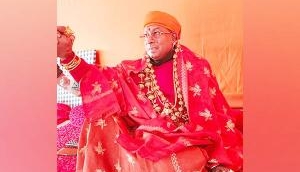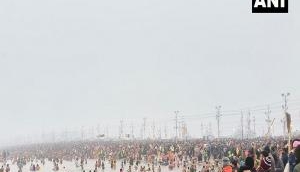The real-life Auro: progeria can't take away Ravina's spunk

The patient
- Ravina, 9, lives in the Sirohi district of Rajasthan, where her father is a labourer
- She goes to school, smiles and commits mischief like any other child
- However, she suffers from progeria, a condition that makes one age seven times faster than normal
The disease
- Progeria is the same disease that Amitabh Bachchan\'s character Auro had in the 2009 film Paa
- There is no known cure for the disease - medicines can only act on some symptoms
- Not many patients live beyond 13 years of age
- Only 140 cases of progeria have been reported in medical history
- Doctors advise taking Ravina abroad for treatment, but her father can\'t afford it
Everybody loved the jocose 'Auro' played by Amitabh Bachchan in R Balki's 2009 movie Paa - be it the characters in the film or the audience.
Life, however, wasn't that kind to nine-year-old Ravina till three years ago.
Where reel life meets real life
Hailing from a small village, Jhadoli, in Sirohi district of Rajasthan, Ravina suffers from the same disease as the fictional Auro - progeria.
Her father, Praveen Kumar Vagri, is a labourer with little means to provide expensive medical care for her.
Owing to her strange appearance, Ravina was an object of constant ridicule for villagers. Her small home was the only world she knew of.
Then, one day, a team of teachers came to her for 'Praveshotsava', a school admission drive. She was standing hesitatingly in a corner when some teachers noticed her. They asked Ravina's family to get her enrolled. It took a lot of convincing for her father to relent.
Though the initial days were difficult, Ravina is now a regular student at a local secondary school. She mingles freely with her peers. People around her have also accepted her special condition.
This has given Ravina a new confidence; she smiles, shouts and commits innocent mischief like any other child.
An incurable disease
However, this does not mean there's hope for a cure. None exists for progeria.
Few people with this extremely rare disease exceed 13 years of age. At least 90% of patients die from complications such as a heart attack or a stroke.
There are treatments for the problems associated with progeria, which can prolong the life of a patient.
"The girl needs to be diagnosed at a high-facility research centre. If she comes to us, we will consult experts and take forward her treatment," says Dr Pradeep Chauhan, a local doctor.
Few people with progeria exceed 13 years of age - 90% of patients die from complications such as a stroke
The medical care does not come cheap, but Ravina's father hasn't lost all hope yet. "I provided her every treatment I could afford. The doctors say we should take her abroad for treatment. My financial condition does not allow this. She has shown a slight improvement. If I get financial help, she may get cured," he hopes.
Multiple cases within a family
Vagri's is an extremely rare family with more than one case of progeria.
Ravina is the eldest of her siblings. She has a brother and twin sisters who are leading a normal life. But one of her younger brothers lost his life due to the same disease.
There is only one other recorded family with more than one case of progeria in India - the family of Bisul Khan and Razia Khatoon in Bihar had seven children, five of them with progeria.
Ageing seven times faster than normal
From Charles Dickens's novel Bleak House to the Oscar-nominated film The Curious Case of Benjamin Button and the TV show The X-Files, progeria has influenced popular culture abundantly.
However, few people know what causes a child's body to look like an aged person's.
The disease is known to scientists as the Hutchinson-Gilford Progeria Syndrome. As the name suggests, it was first described in 1886 by Jonathan Hutchinson, and independently in 1897 by Hastings Gilford.
Progeria occurs in an estimated one out of 4-8 million births. Those born with this disease typically live to their mid-teens, or in rare cases, to their early twenties.
Meg Casey, a US citizen, is known as the oldest survivor of progeria. She died in 1985 at the age of 29. South African hip-hop artist Leon Botha survived this disease for 26 years before his death in June 2011.
Progeria is caused by a mutation in a gene that encodes the protein Lamin-A. The mutation is rarely inherited, as carriers seldom live to reproduce.
Children suffering from progeria start showing signs of ageing from as early as 18 months of age. They age seven times faster than the normal rate.
The earliest symptoms may be growth failure and a scleroderma-like skin condition. Later, the child suffers from loss of hair and body fat, abnormal growth of head and hip dislocation. It causes a distinctive appearance with a small face, recessed jaw and a pinched nose. The symptoms become more marked as the child ages.
As the disease progresses, it results in wrinkled skin, atherosclerosis, kidney failure, loss of eyesight and cardiovascular problems.
However, mental development is not affected by progeria. In fact, intelligence tends to be normal to above average.
Only 140 cases of progeria have been reported in medical history. Currently, there are 100 known patients around the world. However, the Progeria Research Foundation believes there may be as many as 150 undiagnosed cases worldwide.
There is no definite research to ascertain how many children in India suffer the same fate as Ravina. But what is known is the fact that the country has more than 12 million children with disabilities. Only 1% of them have access to schools, despite the right to education being made mandatory.
This is despite the fact that the draft policy on Education of Children With Special Needs, released by the department of education last year, mandates zero rejection for children with disabilities in all educational institutions.
First published: 18 July 2015, 23:26 IST





![BJP's Kapil Mishra recreates Shankar Mahadevan’s ‘Breathless’ song to highlight Delhi pollution [WATCH] BJP's Kapil Mishra recreates Shankar Mahadevan’s ‘Breathless’ song to highlight Delhi pollution [WATCH]](https://images.catchnews.com/upload/2022/11/03/kapil-mishra_240884_300x172.png)

![Anupam Kher shares pictures of his toned body on 67th birthday [MUST SEE] Anupam Kher shares pictures of his toned body on 67th birthday [MUST SEE]](https://images.catchnews.com/upload/2022/03/07/Anupam_kher_231145_300x172.jpg)

